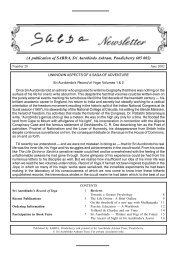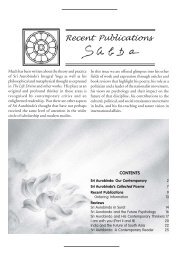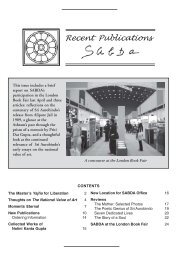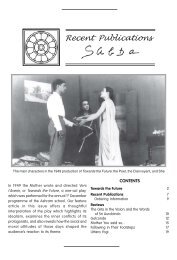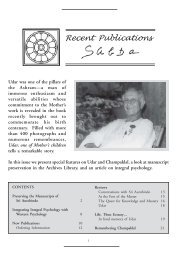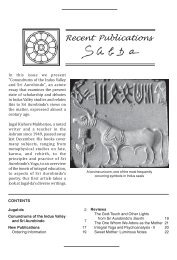Recent Publications - Sabda - Sri Aurobindo Ashram
Recent Publications - Sabda - Sri Aurobindo Ashram
Recent Publications - Sabda - Sri Aurobindo Ashram
You also want an ePaper? Increase the reach of your titles
YUMPU automatically turns print PDFs into web optimized ePapers that Google loves.
2 <strong>Recent</strong> <strong>Publications</strong><br />
Bande Mataram and the Revolutionary Struggle<br />
The newspaper Bande Mataram was a landmark<br />
in the early development of India’s independence<br />
movement. When resistance to the British was<br />
unthinkable to most Indians and independence was a<br />
distant ideal, Bande Mataram circulated across the<br />
country, inspiring people with fiery language and great<br />
acumen. Bipin Chandra Pal launched the newspaper in<br />
August 1906, a year after the British gave the final<br />
announcement that they would partition the presidency<br />
of Bengal into two separate provinces. Bengalis<br />
responded with protests and initiated the first mass<br />
movements of boycott and swadeshi, abstention from<br />
British goods and the promotion of indigenous goods.<br />
The writers of Bande Mataram, like <strong>Sri</strong> <strong>Aurobindo</strong> who<br />
became the chief editor in December 1906, drew<br />
attention across India to the struggle in Bengal,<br />
attempting to inspire a nationwide movement for<br />
independence.<br />
The main nationalist body at the time, the Indian<br />
National Congress, emphasized cooperation with the<br />
British. Established in 1885, its leadership consisted of<br />
middle class Indians who had learned ideas of democracy,<br />
natural rights, and nationhood through English<br />
educations. Hence, these nationalists had deep trust in<br />
the British and confidently petitioned them for various<br />
reforms and for greater representation in the government<br />
of India. Bipin Chandra Pal himself had joined the<br />
Congress in 1886 and had expressed his loyalty to the<br />
British thus: “We are loyal, because we believe in the<br />
workings of the Divine Providence in our national<br />
history, both ancient and modern; because we believe<br />
that God himself has led the British to this country, to<br />
help it in working out its salvation, and realize its<br />
heaven-appointed destiny among the nations of the<br />
world.” 1<br />
When the British partitioned Bengal in 1905 a new<br />
voice emerged within the Congress. The younger<br />
generation of members, known as the “Extremists,”<br />
believed that India must look to itself for advancement,<br />
not to Britain. Pal himself was deeply disillusioned by<br />
the partition and became a main leader of the<br />
Extremists. He wrote, “The belief that England will of<br />
her own free will help Indians out of their longestablished<br />
Civil servitude and establish those free<br />
institutions of Government which she herself values so<br />
much was once cherished, but all hope has now been<br />
abandoned.” 2 The Extremists declared swaraj, “selfrule,”<br />
as their goal and Pal wrote that “God made man<br />
in his own image, essentially and potentially free and<br />
pure. . . . The desire for autonomy is constitutional in<br />
man.” 3<br />
Pal and the other Extremists argued that India could<br />
become a powerful, independent nation only through<br />
struggle, not by petitioning the British. Pal wrote that<br />
a new spirit was sweeping the country, one which<br />
“accepts no other teacher in the art of self-government<br />
except self-government itself. It values freedom for its<br />
own sake, . . . it does not believe serfdom, in any shape<br />
or form, to be a school for real freedom in any country<br />
and under any condition whatever. It holds that the<br />
struggle for freedom itself is the highest tutor of<br />
freedom.” 4 The type of struggle which Pal advocated<br />
was “Passive Resistance, . . . an organized determination<br />
to refuse to render any voluntary and honorary service<br />
to the Government.” 5 Pal’s passive resistance also<br />
involved establishing independent administrative<br />
structures, such as councils, boards, courts, etc. 6<br />
<strong>Sri</strong> <strong>Aurobindo</strong> was also a prominent Extremist, but<br />
he took a different direction than Pal. His nationalistic<br />
interests had developed two decades earlier, in<br />
conjunction with abuse that his father had suffered at<br />
the hands of the British. <strong>Sri</strong> <strong>Aurobindo</strong> knew that the<br />
swadeshi movement in Bengal had great potential in<br />
terms of the development of a widespread independence<br />
movement. Hence, he began traveling with Pal in spring<br />
1906, as the latter addressed enormous crowds. Later,<br />
in August, Pal invited <strong>Sri</strong> <strong>Aurobindo</strong> to begin writing<br />
for Bande Mataram. However, the editorial board<br />
strongly preferred <strong>Sri</strong> <strong>Aurobindo</strong>, so the relationship<br />
between Pal and the newspaper was severed in<br />
December, and <strong>Sri</strong> <strong>Aurobindo</strong> became the chief editor. 7<br />
The key issue was that <strong>Sri</strong> <strong>Aurobindo</strong> brought a<br />
revolutionary approach to Bande Mataram. <strong>Sri</strong><br />
<strong>Aurobindo</strong> and Pal were both Extremists, but the latter,<br />
in comparison to <strong>Sri</strong> <strong>Aurobindo</strong>, remained within the



